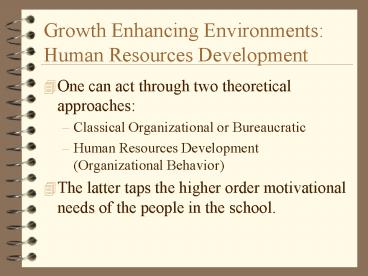Growth Enhancing Environments: Human Resources Development PowerPoint PPT Presentation
Title: Growth Enhancing Environments: Human Resources Development
1
Growth Enhancing Environments Human Resources
Development
- One can act through two theoretical approaches
- Classical Organizational or Bureaucratic
- Human Resources Development (Organizational
Behavior) - The latter taps the higher order motivational
needs of the people in the school.
2
School Climate
- Different schools have distinct personalities due
to the particular social system of each school. - This social system has a CLIMATE that is the
defined as the characteristics of the total
environments in a school building (Owens, p.
162). - Renato Tagiuris model identifies four elements
that comprise climate.
3
(No Transcript)
4
Research on Climate (Wm. Ouchi) Theory Z
- Type A (American) Short Term Employment
- Type J (Japanese) Lifetime employment
- Type Z (Modified American) Long-term employment
5
Research on Climate (Wm. Ouchi) Theory Z
- Type A Individual decision making
- Type J Consensual decision making
- Type Z Consensual decision making
- Type A Specialized career path
- Type J Nonspecialized career path
- Type Z Moderately specialized career path
6
Tom Peters In Search of Excellence
- Research showed that successful organizations,
including schools, had a consistent theme - the power of values and culture in these
corporations rather than procedures and control
systems, provides the glue that holds them
together, stimulates commitment to a common
mission, and galvanizes the creativity and energy
of their participants. (Owens, p. 164).
7
Scheins Model of Levels of Culture (p. 168)
- Culture is based on norms, values, and belief
systems - And this leads to behaviors and artifacts based
on these norms, values, and belief systems
8
Organizational Climate
- Climate is measured by assessing the perceptions
of individuals concerning the aspects of climate
culture, ecology, organization, and milieu. - We must remember that schools and districts will
have multiple cultures.
9
Rensis Likerts Cause and Effect
- Likerts analysis led him to conclude that there
are causal variables under the control of the
principal that affect climate and organization
performance - Organization structure bureaucratic or flexible
- Leadership style authoritative or democratic
- Philosophy of operation consensus decision
making or not
10
Rensis Likerts Cause and Effect
- These choices are critical to determining the
nature of the management system in the
organization. That is, Likerts System 1, 2, 3,
or 4. - System 4 is the only effective System.
- This is directly related to student achievement
level increases.
11
Climate Studies
- Various instruments can measure climate, one of
the earliest being the OCDQ by Halpin and Croft. - The accreditation process requires schools to use
climate instruments, and then to develop a plan
to improve those areas that are weak.
12
Likerts Linking Pin Concept
- Likert noted that any effective System 4 will
need to break into work groups that are small
enough to work and communicate together, and
close enough to the problem to make effective,
creative decisions. - This requires the pyramidal structure depicted on
p. 191 in which there is someone linked to groups
above and below a groups place on the
organization chart. - ltThe Endgt

